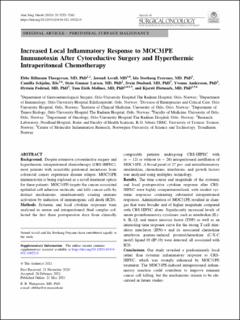| dc.contributor.author | Thorgersen, Ebbe Billmann | |
| dc.contributor.author | Asvall, Jørund | |
| dc.contributor.author | Frøysnes, Ida Storhaug | |
| dc.contributor.author | Schjalm, Camilla | |
| dc.contributor.author | Larsen, Stein Gunnar | |
| dc.contributor.author | Dueland, Svein | |
| dc.contributor.author | Andersson, Yvonne | |
| dc.contributor.author | Fodstad, Øystein | |
| dc.contributor.author | Mollnes, Tom Eirik | |
| dc.contributor.author | Flatmark, Kjersti | |
| dc.date.accessioned | 2021-09-17T06:29:37Z | |
| dc.date.available | 2021-09-17T06:29:37Z | |
| dc.date.created | 2021-06-17T18:33:01Z | |
| dc.date.issued | 2021 | |
| dc.identifier.citation | Annals of Surgical Oncology. 2021, . | en_US |
| dc.identifier.issn | 1068-9265 | |
| dc.identifier.uri | https://hdl.handle.net/11250/2778771 | |
| dc.description.abstract | Background - Despite extensive cytoreductive surgery and hyperthermic intraperitoneal chemotherapy (CRS-HIPEC), most patients with resectable peritoneal metastases from colorectal cancer experience disease relapse. MOC31PE immunotoxin is being explored as a novel treatment option for these patients. MOC31PE targets the cancer-associated epithelial cell adhesion molecule, and kills cancer cells by distinct mechanisms, simultaneously causing immune activation by induction of immunogenic cell death (ICD).
Methods - Systemic and local cytokine responses were analyzed in serum and intraperitoneal fluid samples collected the first three postoperative days from clinically comparable patients undergoing CRS-HIPEC with (n = 12) or without (n = 26) intraperitoneal instillation of MOC31PE. A broad panel of 27 pro- and antiinflammatory interleukins, chemokines, interferons, and growth factors was analyzed using multiplex technology.
Results - The time course and magnitude of the systemic and local postoperative cytokine response after CRS-HIPEC were highly compartmentalized, with modest systemic responses contrasting substantial intraperitoneal responses. Administration of MOC31PE resulted in changes that were broader and of higher magnitude compared with CRS-HIPEC alone. Significantly increased levels of innate proinflammatory cytokines, such as interleukin (IL)-6, IL-1β, and tumor necrosis factor (TNF) as well as an interesting time response curve for the strong T-cell stimulator interferon (IFN)-γ and its associated chemokine interferon gamma-induced protein/chemokine (C-X-C motif) ligand 10 (IP-10) were detected, all associated with ICD.
Conclusions - Our study revealed a predominately local rather than systemic inflammatory response to CRS-HIPEC, which was strongly enhanced by MOC31PE treatment. The MOC31PE-induced intraperitoneal inflammatory reaction could contribute to improve remnant cancer cell killing, but the mechanisms remain to be elucidated in future studies. | en_US |
| dc.language.iso | eng | en_US |
| dc.publisher | Springer | en_US |
| dc.rights | Navngivelse 4.0 Internasjonal | * |
| dc.rights.uri | http://creativecommons.org/licenses/by/4.0/deed.no | * |
| dc.title | Increased Local Inflammatory Response to MOC31PE Immunotoxin After Cytoreductive Surgery and Hyperthermic Intraperitoneal Chemotherapy | en_US |
| dc.type | Journal article | en_US |
| dc.type | Peer reviewed | en_US |
| dc.description.version | publishedVersion | en_US |
| dc.source.pagenumber | 0 | en_US |
| dc.source.journal | Annals of Surgical Oncology | en_US |
| dc.identifier.doi | 10.1245/s10434-021-10022-0 | |
| dc.identifier.cristin | 1916579 | |
| cristin.ispublished | true | |
| cristin.fulltext | original | |
| cristin.qualitycode | 1 | |

